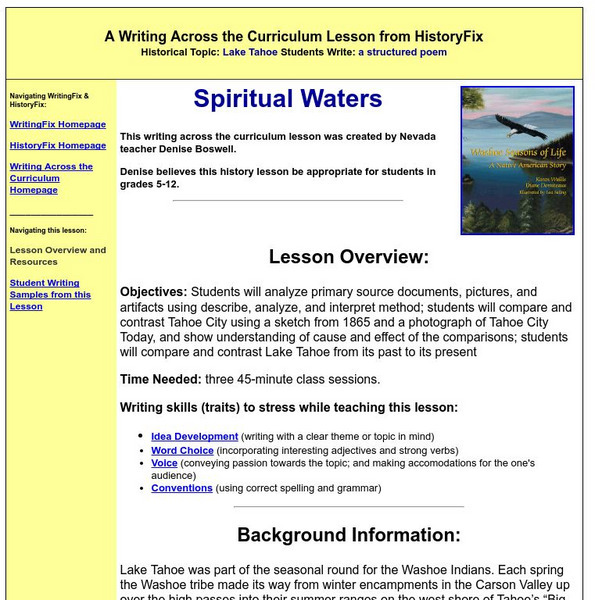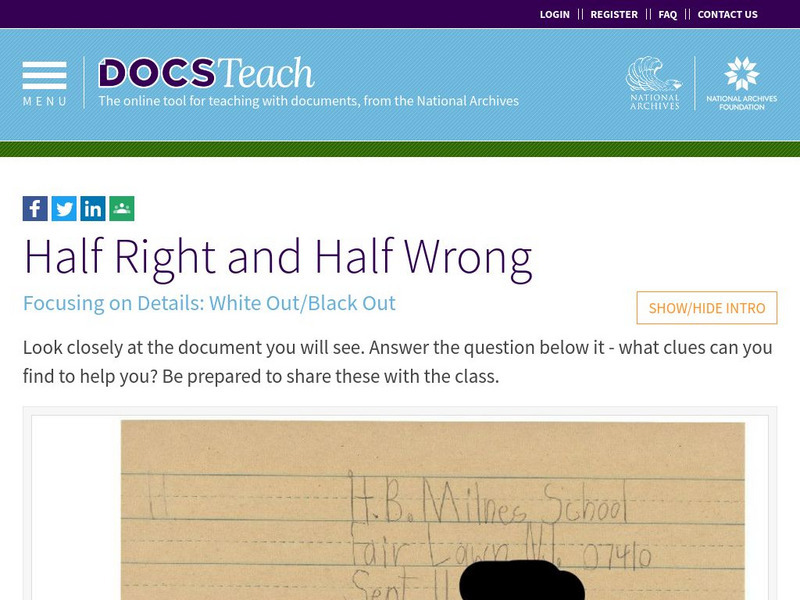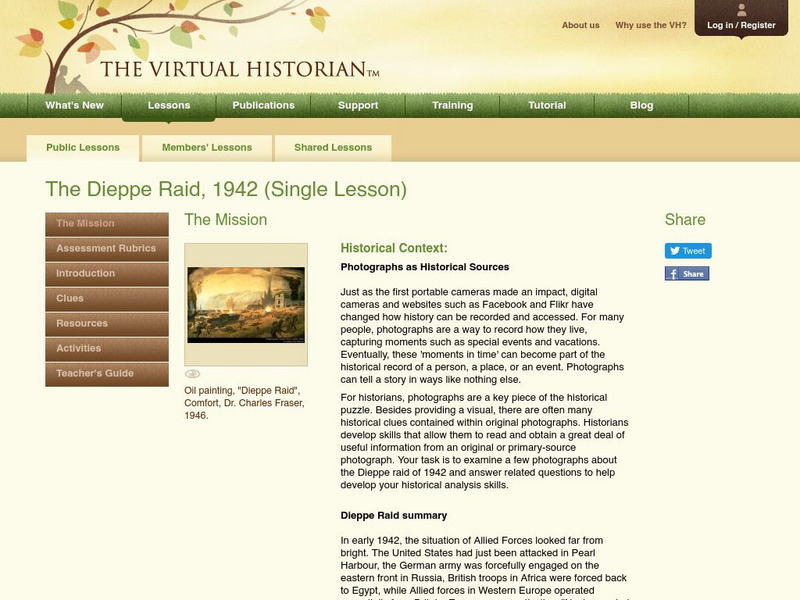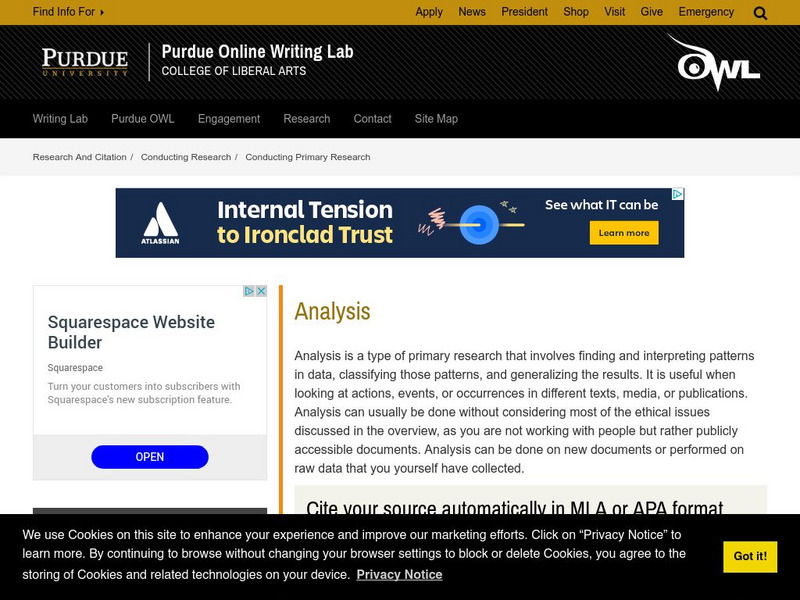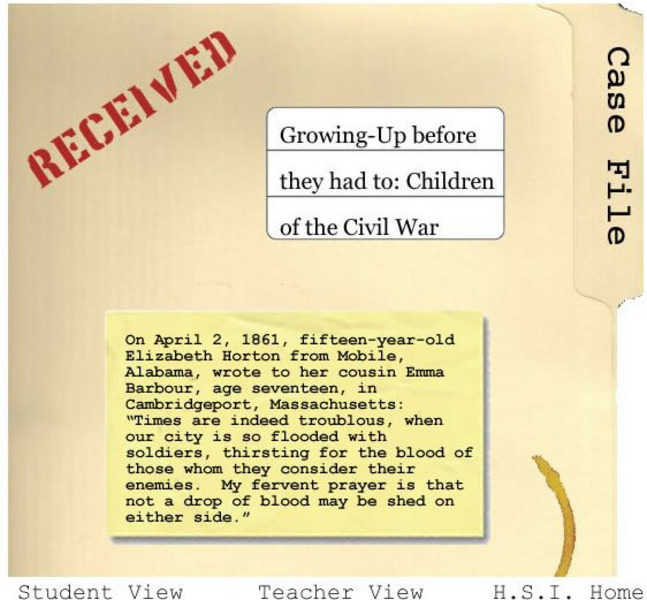Library of Congress
Loc: For Teachers: Analyzing Primary Source Documents
These student worksheets and activities help students analyze many different types of primary source documents. Life histories, objects, and photographs are all used to engage students.
Harry S. Truman Library and Museum
Truman Library & Museum: Incorporating Primary Sources in the Classroom
Students and teachers are given direction in how to work with the primary source materials of the Harry S Truman Presidential Library.
Library of Congress
Loc: 1900 America: Primary Sources and Epic Poetry
To better understand the United States at the end of the nineteenth century, this interdisciplinary lesson integrates analyzing historical primary resources with literary analysis. Students work in groups and express themselves...
Library of Congress
Loc: Slavery in the United States: Primary Sources
This lesson introduces students to primary sources- what they are, their great variety, and how they can be analyzed. The lesson begins with an activity that helps students understand the historical record. Students then learn techniques...
University of California
Uc Irvine: Distinguishing Between Primary & Secondary Sources
This site has an online quiz to test your knowledge of primary and secondary sources.
Stanford University
Sheg: Document Based History: Reading Like a Historian: Evaluating Sources
[Free Registration/Login Required] Are all historical sources equally trustworthy? How might the reliability of a historical document be affected by the circumstances under which it was created? In this activity, students sharpen their...
Writing Fix
Writing Fix: Spiritual Waters
After analyzing primary source documents, pictures, and artifacts, students will use the describe, analyze, and interpret method to compare and contrast a sketch of Tahoe City in 1865 to a photograph of modern day Tahoe City. Then...
PBS
Pbs Learning Media: Scapegoating Asian Americans During the 1980s
Analyze primary sources in the media gallery and create an illustrated poem to learn how Asian Americans were scapegoated for the downturn of the U.S. economy and American auto industry during the 1980s.
PBS
Pbs Learning Media: Villainizing Japanese Americans During the Wwii Era
Analyze primary sources in the media gallery and create an illustrated poem to learn how Japanese Americans were impacted by anti-Chinese exclusion policies of the 1800s, and why it escalated during World War II. As a result, Americans...
PBS
Pbs Learning Media: Anti Filipino Sentiment of the Early 1900s
Analyze primary sources in the media gallery and create an illustrated poem to learn how and why Filipino Americans faced racial prejudice and discrimination during the early 1900s. This anti-Asian racism is connected to U.S....
Curated OER
History Matters: Making Sense of Documents
Designed to help teachers and students make effective use of primary documents. There are well written section on how to make sense of numbers, ads, music, diaries, and more. included are interactive activities for students to help them...
Library of Congress
Loc: Teachers: America at the Centennial
A lesson plan requiring student to analyze primary documents from the Philadelphia Centennial Exposition of 1876. Students interpret what these historical artifacts say "about the lives and values of Americans in 1876" among other things.
Kentucky Educational Television
Ket: A State Divided: Exploring the Civil War Through Images
A State Divided: Exploring the Civil War Through Images includes 75 images related to the Civil War in Kentucky, ranging from medals and photographs to portraits and weapons. The goal is to provide images of artworks, artifacts,...
PBS
Pbs Learning Media: The Challenges of Making Peace: The Great War
In this interactive instructional activity, students watch videos from AMERICAN EXPERIENCE: The Great War, read primary source documents and video transcripts, and analyze data to better understand how and why the U.S. and European...
Georgia Department of Education
Ga Virtual Learning: Significance of Audience Analysis: Target Populace [Pdf]
This is a 14-page PDF article concerning audience analysis for a persuasive speech. It includes the importance of understanding your audience, methods used to analyze a specific audience, and the five layer of any given audience alalysis.
US National Archives
Docsteach: Half Right, Half Wrong: Analyzing a Letter About Ford Pardoning Nixon
In this activity, students will analyze a document sent from a child to President Gerald Ford in 1974. Anthony Ferreira wrote to the president to express his opinion regarding the pardon of Richard Nixon.
PBS
Pbs Learning Media: Ken Burns in the Classroom: Collection
Ken Burns and his collaborators have been creating historical documentary films for more than forty years. Known for a signature style that brings primary source documents, images, and archival video footage to life on screen, these...
Stanford University
Sheg: Document Based History: Reading Like a Historian: World War I & 1920s
[Free Registration/Login Required] Students use primary source documents to investigate historical events. In this lesson students analyze historical evidence as they consider eight document-based questions about the post-war era of the...
Other
The Virtual Historian: Dieppe Raid August 19, 1942
Students will develop critical thinking skills as they examine pictures from the Dieppe Raid. They will analyze primary sources and make inferences. Lesson length is 60 minutes and includes audio reading of the text.
Huntington Library
Huntington Library: Benjamin Franklin: Colonial Printer and Journalist
This lesson looks at the early career of Benjamin Franklin and he contributed to the spread of literacy in America, as well as his public service record at that time. Students will examine and analyze primary source documents to...
Online Writing Lab at Purdue University
Purdue University Owl: Analysis
This entry focuses on using analysis to interpret primary resources; it provides methods and examples of analysis. W.9-10.10 Write Routinely
Library of Congress
Loc: Teachers: Geography and Its Impact on Colonial Life
Beginning with a discussion on how people adapt to or relocate to environments, this lesson encourages learners to explore why the Colonists settled in specific regions. In groups, students examine primary documents, analyzing Colonists'...
Smithsonian Institution
Smithsonian Education: Art to Zoo Playing Historical Detective
Students become detectives, reading and analyzing documents and artifacts as clues to the life of a nineteenth century woman, Annie Steel. The students then use various materials to create a series of collages.
Other
Historical Scene Investigation: Children of the Civil War
Students analyze engaging documents written by children of the Civil War. After studying the documents, they are to complete various tasks as if they were there.






